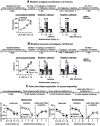Effect of Selective Lesions of Nucleus Accumbens µ-Opioid Receptor-Expressing Cells on Heroin Self-Administration in Male and Female Rats: A Study with Novel Oprm1-Cre Knock-in Rats
- PMID: 36717230
- PMCID: PMC10010456
- DOI: 10.1523/JNEUROSCI.2049-22.2023
Effect of Selective Lesions of Nucleus Accumbens µ-Opioid Receptor-Expressing Cells on Heroin Self-Administration in Male and Female Rats: A Study with Novel Oprm1-Cre Knock-in Rats
Abstract
The brain µ-opioid receptor (MOR) is critical for the analgesic, rewarding, and addictive effects of opioid drugs. However, in rat models of opioid-related behaviors, the circuit mechanisms of MOR-expressing cells are less known because of a lack of genetic tools to selectively manipulate them. We introduce a CRISPR-based Oprm1-Cre knock-in transgenic rat that provides cell type-specific genetic access to MOR-expressing cells. After performing anatomic and behavioral validation experiments, we used the Oprm1-Cre knock-in rats to study the involvement of NAc MOR-expressing cells in heroin self-administration in male and female rats. Using RNAscope, autoradiography, and FISH chain reaction (HCR-FISH), we found no differences in Oprm1 expression in NAc, dorsal striatum, and dorsal hippocampus, or MOR receptor density (except dorsal striatum) or function between Oprm1-Cre knock-in rats and wildtype littermates. HCR-FISH assay showed that iCre is highly coexpressed with Oprm1 (95%-98%). There were no genotype differences in pain responses, morphine analgesia and tolerance, heroin self-administration, and relapse-related behaviors. We used the Cre-dependent vector AAV1-EF1a-Flex-taCasp3-TEVP to lesion NAc MOR-expressing cells. We found that the lesions decreased acquisition of heroin self-administration in male Oprm1-Cre rats and had a stronger inhibitory effect on the effort to self-administer heroin in female Oprm1-Cre rats. The validation of an Oprm1-Cre knock-in rat enables new strategies for understanding the role of MOR-expressing cells in rat models of opioid addiction, pain-related behaviors, and other opioid-mediated functions. Our initial mechanistic study indicates that lesioning NAc MOR-expressing cells had different effects on heroin self-administration in male and female rats.SIGNIFICANCE STATEMENT The brain µ-opioid receptor (MOR) is critical for the analgesic, rewarding, and addictive effects of opioid drugs. However, in rat models of opioid-related behaviors, the circuit mechanisms of MOR-expressing cells are less known because of a lack of genetic tools to selectively manipulate them. We introduce a CRISPR-based Oprm1-Cre knock-in transgenic rat that provides cell type-specific genetic access to brain MOR-expressing cells. After performing anatomical and behavioral validation experiments, we used the Oprm1-Cre knock-in rats to show that lesioning NAc MOR-expressing cells had different effects on heroin self-administration in males and females. The new Oprm1-Cre rats can be used to study the role of brain MOR-expressing cells in animal models of opioid addiction, pain-related behaviors, and other opioid-mediated functions.
Keywords: CRISPR; caspase 3 lesion; heroin self-administration; knockin; mu opioid receptor; pain.
Copyright © 2023 the authors.
Figures







References
-
- Adhikary S, Caprioli D, Venniro M, Kallenberger P, Shaham Y, Bossert JM (2017) Incubation of extinction responding and cue-induced reinstatement, but not context- or drug priming-induced reinstatement, after withdrawal from methamphetamine. Addict Biol 22:977–990. 10.1111/adb.12386 - DOI - PMC - PubMed
Publication types
MeSH terms
Substances
Grants and funding
LinkOut - more resources
Full Text Sources
Medical
Research Materials
